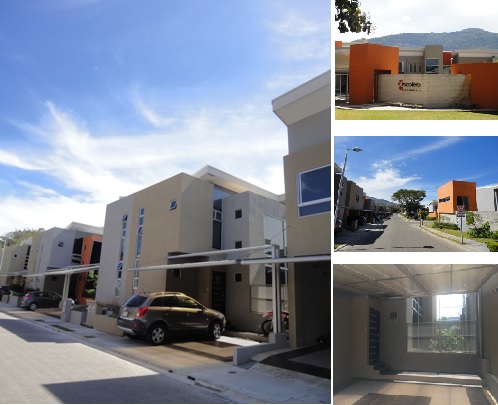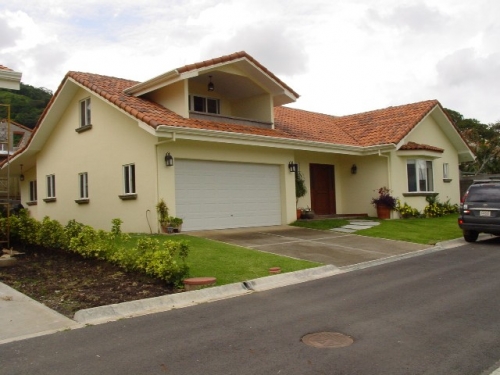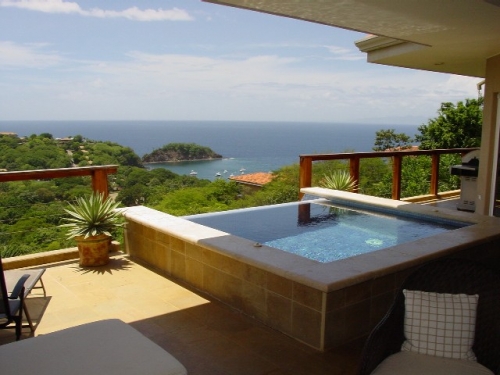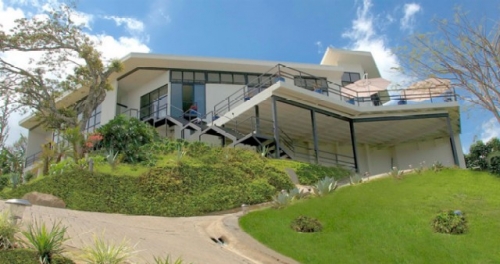Costa Rica Guide
Costa Rica Real Estate
List your property today!
Inclusion of real estate listings at Costa Rica Guide is
absolutely free of charge.
Featured Properties
Costa Rica Guide - Costa Rica Real Estate
A Silicon Republic: A few years ago, Costa Rica was known mainly for its bananas. Then the world's biggest semiconductor maker came calling. Lessons from the high-tech frontier
Brad Stone
Newsweek
August 28, 2000
Federico Fernandez awakens every morning at 6 to get to his dream job on time. He climbs into his battered '88 Toyota and drives past the bread and machinery factories that surround the land he shares with the rest of his extended family in San Jose, Costa Rica. Fernandez has to lock the driveway gate behind him--the workers have recently taken to kidnapping his dogs because his uncle has filed a noise complaint against the factories. He navigates through the morning traffic, around tire-swallowing chuckholes, and through the city air that smells of meat-processing plants and diesel fumes.
But 10 minutes later everything changes. Fernandez arrives at the portal to Costa Rica's new information economy. The lawns are well manicured, the security checkpoint is manned by uniformed guards and 10-foot-high barbed wire surrounds two gleaming chip-production facilities. This is the three-year-old plant of Intel, the world's largest maker of silicon processors, the brains of the world's PCs.
In the past, citizens of this onetime "banana republic" in Central America might have treated Intel as a Yanqui imperialist, an exploitative multinational. But today, with strikingly little dissent, Costa Ricans are welcoming Intel as a savior--a high-flying, high-tech company that could bring the country into step with the industrialized world. Last year, while the forces of anti-globalization demonstrated in Seattle during meetings of the World Trade Organization, Intel was transforming the Costa Rican economy. The country's GDP surged by 8.4 percent, with output from the Intel plant comprising half of that growth and 37 percent of the country's exports. That's more than the traditional exports of coffee and bananas combined, and the largest share of a country's exports by a single company anywhere in the world, economists say. At a time when tech stocks are back on track, it's also a source of envy for other developing nations that are looking to boost their own fortunes by hosting new economy firms.
Some Costa Rican economists worry that the nation is becoming too dependent on Intel, and that the company is getting cheap labor while giving back little in return (it won't have to pay local taxes for years). But others portray Intel's success in Costa Rica as a can't-lose proposition. Northern Latin American countries like Costa Rica, Mexico and the Dominican Republic have stopped resisting foreign firms and are instead successfully linking their markets to the pace-setting U.S. economy, says Moises Naim, editor of Foreign Policy magazine and a former Venezuelan Economic minister. Costa Rican President Miguel Angel Rodriguez has publicly joked that the Intel plant manager has a job more important than his own. Yet he has nothing but praise for the "Intel miracle." "We needed to have a presence on the economic stage and strengthen our ability to attract high-tech foreign investment," he said in an e-mail interview with NEWSWEEK. "Intel did that for us."
At first glance, the marriage of country and company is an odd one. Intel has been the largest producer of silicon chips since 1992, and is one of the strongest engines of growth in the new economy. Costa Rica, meanwhile, has the population of South Carolina and the economic output of North Dakota. It was dependent on the volatile coffee and banana crops until the 1970s, when it expanded into areas like tourism and textiles. But NAFTA demolished the textile trade in the early '90s, luring textile plants to Mexico for cheaper workers and more favorable trade conditions. Mired in a recession in the mid '90s, the country decided to use its well-educated work force (95 percent literate, the highest rate in Latin America) to court the electronics companies that were reshaping the U.S. economy to the north.
At the same time Intel was looking to build another assembly/test plant--the factory that takes the chips manufactured at fabrication plants and turns them into working processors. The company spreads such plants around the world to reduce the risks of concentrating production in one region and, of course, to capitalize on the plentiful, cheap labor and tax incentives in many lesser developed countries.
Intel's early response to Costa Rica's bid to host the new factory was not promising. "Putting our facility in Costa Rica would be like putting a whale in a swimming pool," an Intel official told Thomas Duena, now the country's secretary of Trade. But after an intense, yearlong courtship, Intel chose Costa Rica over Mexico, Singapore and Taiwan. Officials cited its friendly, stable government and the literate work force. They also got the good deal the country offers to all large corporations: eight years without taxes, four additional years with a 50 percent discount and a bulk rate on electricity.
Some local economists question Intel's real impact on the country. Since no money flows into the national coffers, the company doesn't help with issues like road improvements or phone-network upgrades. And the plant in San Jose must import more than 90 percent of its supplies from abroad since no local electronics industry yet exists. By contrast, an Intel plant in Taiwan or Singapore buys 80 percent of its supplies locally, sending more money into those economies. Intel boosters think this will take time to develop in Costa Rica. But for now, the company's actual input takes the form of salaries, electricity bills and payments to contractors.
Other critics wonder if the country's dependence on Intel might actually destabilize the economy. This year, for instance, the plant's output will peak and even slow a bit as production shifts to the Pentium V. As a result, Costa Rica's growth is expected to plunge from 8 percent back down to 4 percent. "Intel's fluctuations have become Costa Rica's fluctuations," says Eduardo Lizano, head of the country's central bank. The hope is that Intel is now promoting the high-tech cachet and skills to attract new foreign companies to offset those vacillations. The chipmaker sends execs to Costa Rica's foreign-investment symposiums to talk up the experience, and has already helped lure other firms such as pharmaceutical giant Abbott and Procter & Gamble. Still, the country is beset by lagging reforms in other sectors; efforts to open up the state-owned electricity and telecom monopoly, ICE, provoked violent strikes last March.
To fully gauge Intel's day-to-day effect on Costa Rica, you have to look at the daily lives of the 2,000, mostly twentysomething workers. For Federico Fernandez, for instance, working at Intel has been a constant education: he calculates that he's logged 488 hours of training in three years and has visited plants in Malaysia, Oregon and Arizona. Then there's the money. Intel pays its technician-level employees an average of $5,000 a year. While that's considerably less than the $20,000 to $40,000 a comparable employee in the United States might earn, it's well above the Costa Rican per capita income of $3,200. Moreover, employees get bonuses three times a year and receive as many as 50 to 100 stock options that vest over five years. Fernandez says chips are far more challenging than bananas, the country's other major export. "Bananas will be bananas today and bananas tomorrow," he says. "When you're making chips... you always learn something new."
For now most Costa Ricans are enjoying the new gloss that Intel has brought to their country and many of their lives. Systems manager Karla Cruz, 26, says that if it weren't for Intel, she would still be working at a local newspaper-printing facility. Costa Rican officials hope young people like Cruz will eventually start their own local tech businesses. Those could grow into an authentic, high-tech community, creating genuine national wealth. Then Costa Rica will really have a chance to join the Information Age revolution, and the Intel miracle will be worthy of its name.
Copyright 2000 Newsweek, Inc.
Note: The above information is not to be used for any other purpose other than private study, research, criticism or review. Thank you.






